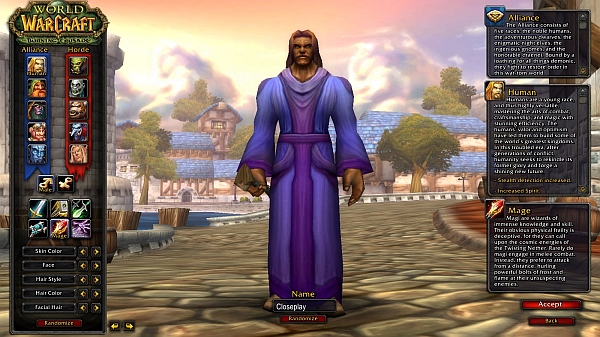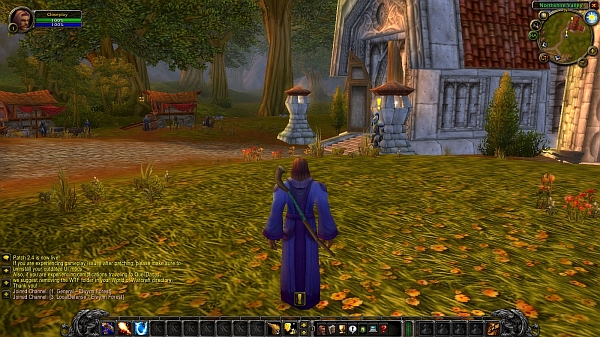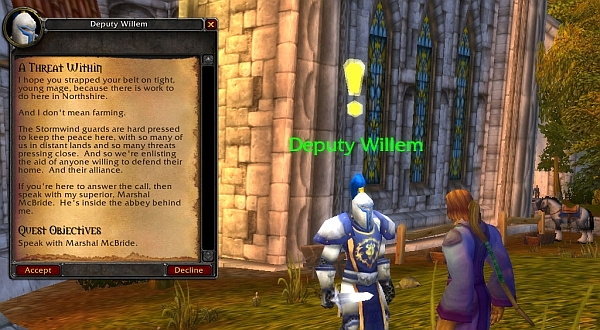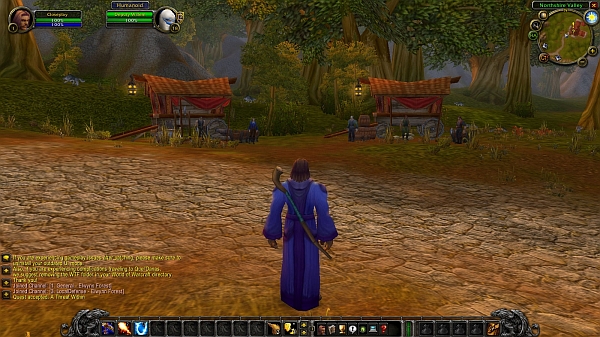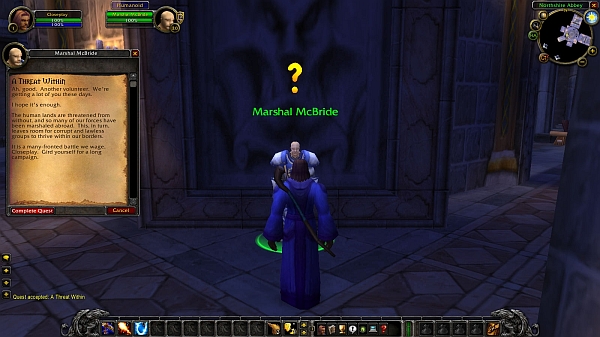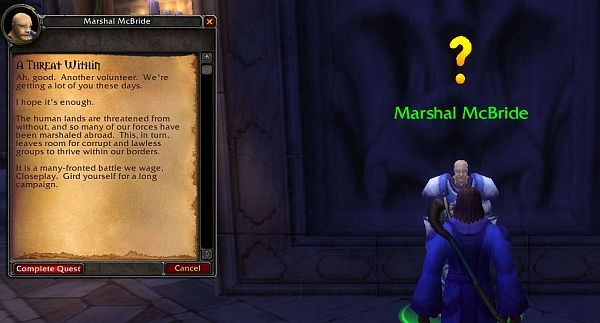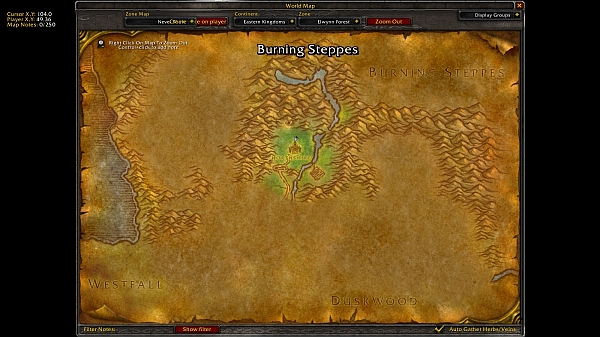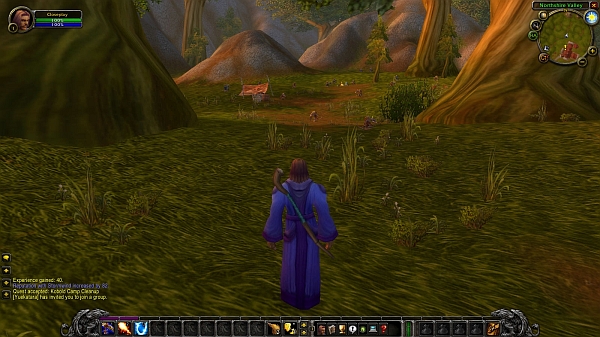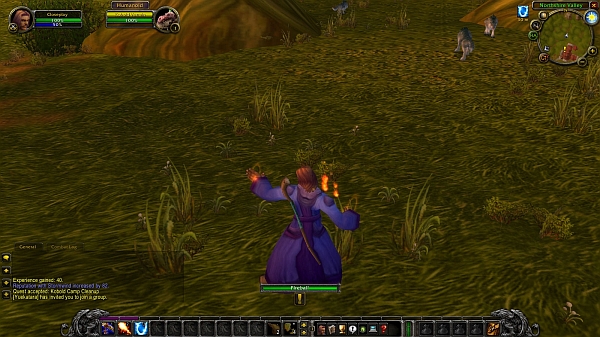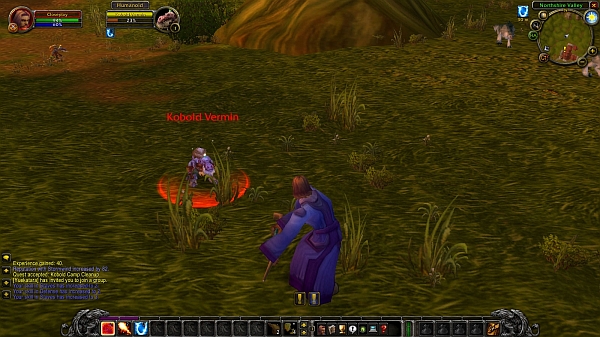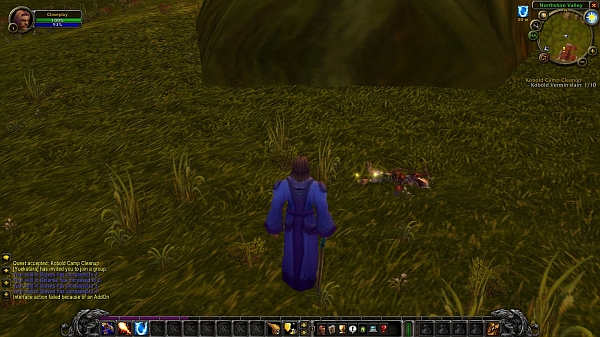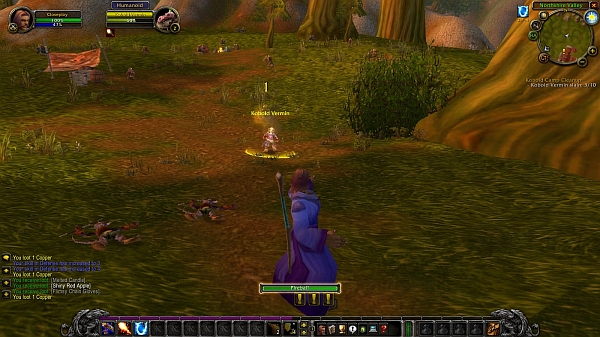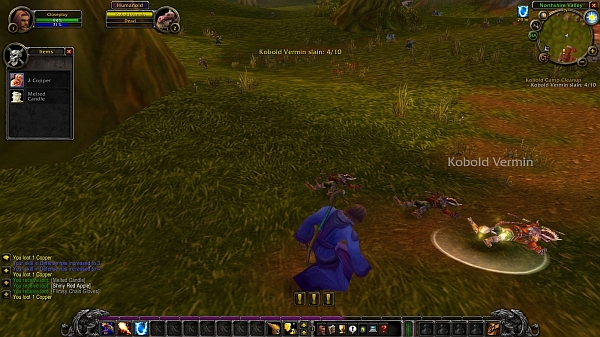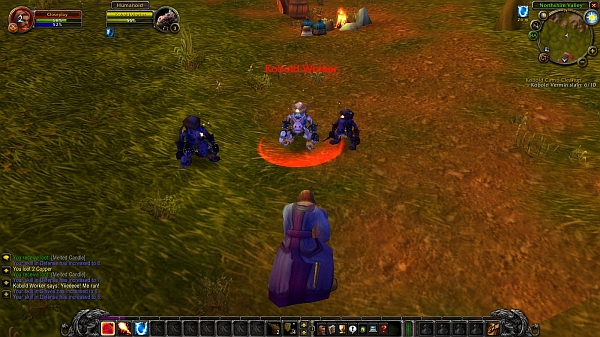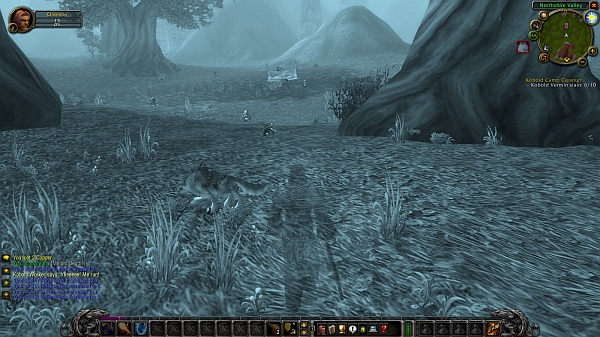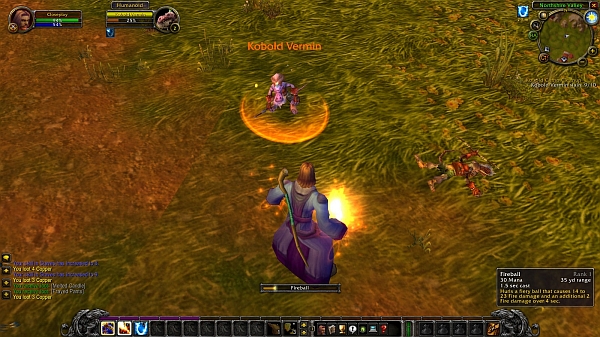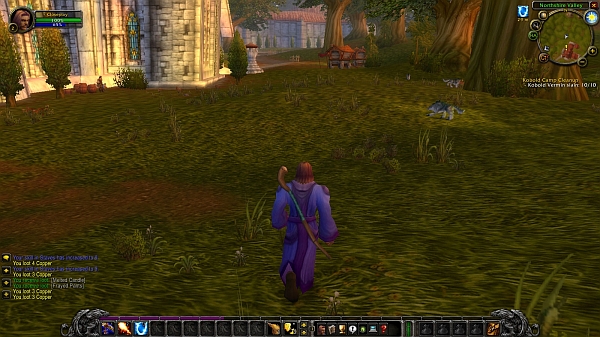|
NOT JUST A WALK-THROUGH THE PARK
Walk-throughs are a common genre of video game writing. Walk-throughs provide a brief, step-by-step description, map, and set of directions for the player to follow. Walk-throughs are often part of the user manual to help orient new players to how to interface with the game, how to make a character, how to move and fight, and how to navigate the game world. Hint books and strategy guides also contain walk-throughs of difficult regions, dungeons, puzzles, and battles. Here is a simple walk-through of a first level, brand new World of Warcraft character. By close playing even something as rudimentary as creating a starting character and going on their first quest can provide opportunities for close reading, analysis, reflection, and questions, particularly of choices, options, effects, game play, game text, and game world.
Closeplay the MageFrom the character creation screen, players can select from ten playable character races and nine character classes. The player decides that Closeplay will be human, male, and a mage. The character creation screen describes humans: "Humans are a young race, and thus highly versatile, mastering the arts of combat, craftsmanship, and magic with stunning efficiency. The human's valor and optimism have led them to build some of the world's greatest kingdoms. In this troubled era, after generations of conflict, humanity seeks to rekindle its former glory and forge a shining new future." The screen also describes mages: "Magi are wizards of immense knowledge and skill. Their obvious physical frailty is deceptive, for they can call upon the cosmic energies of the Twisting Nether. Rarely do magi engage in melee combat. Instead, they prefer to attack from a distance, hurling powerful bolts of frost and flame at their unsuspecting enemies." Here the language of what it means to be human in WoW is in part defined by "efficiency" and a desire for "former glory." How might this language be compared to the descriptions of other game races? How might the description of humans be read out of the game and into the real world? As for mages, how might the binary opposition of "physical frailty" and "immense knowledge" be unpacked? Why are mages described as necessarily combative?
After putting the finishing touches on the character and giving the character a name, the player clicks "Accept" and the character is dropped into the game world. But first a short cinematic (a little animated film) is played to explain the place and goals of humanity in the game world, to situate and carefully insert the character into the "story" of the game. The animation exhorts, "You must defend the kingdom against the foul mongrels that encroach upon it and hunt down the subversive traitors who seek to destroy it from within. Now is the time for humans. Now humanity's greatest chapter can be told." Again, questions can be raised about the limited choices offered to players in terms of character appearance and customization. What does it mean to be able to change skin color on a sliding scale? Questions can also be asked about the language used by the cinematic, particularly focusing on words like "mongrels" and "subversive traitors" and "greatest chapter can be told."
Closeplay begins in Northshire Valley, a "newbie" area (or zone) for starting player characters (PCs). Everything in Northshire is designed to acquaint the player with the basics of the game, game play, and the game world. Looking around, Closeplay sees a church-like building ahead, several wagons, and non-player characters (NPCs) to the left, and what looks like a guard in plate armor nearby. The guard has a bright yellow exclamation point floating over his head, which means he has something important to tell the character or a quest to give. The guard's name is Deputy Wilhelm. The heads-up displays tell the player information about their character and the world around them, as well as let them fight, use abilities, check inventory, and chat. Typical heads-up displays include the mini-map in the upper right-hand corner of the screen, the action button bar running along the bottom, the chat window in the bottom left, and the character profile and health and mana meters in the upper left.
Using the keyboard to move, the player "drives" Closeplay over to Deputy Wilhelm. Right-clicking on the guard opens a quest window. The quest, called "A Threat Within," is spelled-out for the player. The quest says, "I hope you strapped your belt on tight, young mage, because there is work to do here in Northshire. And I don't mean farming." Quest text gives players (and characters) clues about the game world, about the different plots and situations and events going on locally and globally, as well as directs them to talk to other NPCs, to accomplish some task, to travel to a new locale, or to kill some target. Deputy Wilhelm asks Closeplay if he's ready to "answer the call" and to speak with Marshal McBride inside the abbey.
Accepting the quest places the quest in the character's "quest log." The player must decide whether to proceed on the quest, in this case to talk to Marshal McBride, or do something else. The character can take on multiple quests simultaneously. Some quests lead the character on a chain of quests. Completing a quest often gives the character a reward, usually a combination of experience (which is a measure of how well-traveled and well-developed and well-trained and how powerful the character is), money, or items. Closeplay takes a look around before heading into the abbey. The wagons nearby have NPC merchants and tradesfolk in front of them; merchants and tradespeople sell useful materials and equipment, as well as buy unwanted items from the player character.
Entering the Northshire Abbey, Closeplay sees Marshal McBride down the entrance hall. A yellow question mark means that McBride is expecting Closeplay to "turn in" his quest to talk to him. By talking to McBride, Closeplay gains experience and the next part of this particular quest line of "A Threat Within." McBride says, "Ah, good. Another volunteer." Looking carefully at the NPCs, their names, the setting of Northshire, players can try to unpack the very Western European basis for all "humanity" in the game. Questions about being conscripted to be part of a "citizen militia" might also be raised. What does it mean to be called to battle when the armies of Stormwind, the human capital city, are away? What does it mean to be called to battle in a real world wartime present?
Marshal McBride gives him his first real task, his first taste of battle: "Your first task is one of cleansing, Closeplay." Closeplay is to kill 10 Kobold Vermin and then return to McBride. Clearly, the language of "cleansing" is problematic. What does it mean to "cleanse" Northshire of "vermin?" Is it all right that the vermin are not humans but kobolds, less-than-humans?
Closeplay checks the in-game map. The kobolds are north of the abbey. The blank areas of the map mean that Closeplay has not yet traveled there. As soon as the character "discovers" a new area, the map will be filled in.
The player runs Closeplay north from the abbey, passing other NPCs. In the trees beyond, he sees wandering wolves and a camp of kobolds. Because the area is for new characters, none of these low level creatures are aggressive, meaning they will not initiate combat with the character. Using the button bar, one of the icons is a glowing, icy shield. Clicking on the button casts the spell Frost Armor, which gives Closeplay added protection. Then selecting a kobold target, the player clicks the spell Fireball, which casts a bolt of flame at the creature. Attacking a creature causes the creature to attack back.
Closeplay is equipped with a starting, simple wooden staff, which he can use in melee combat with the kobold. As the character gains in experience, skill, and wealth, he can acquire better weapons, armor, and equipment. As described above, mages are not particularly good close-quarter fighters. While in combat, Closeplay can swing his staff and cast spells.
As long as the kobold does not do enough damage to reduce Closeplay to zero Hit Points (a measure of the character's life force and hardiness), he will live to fight another day. Taking time to rest or to eat in-game food will restore Hit Points. Character classes with the ability to heal can also restore Hit Points. Once a creature is dead, the player can click on the body to loot it of any valuables.
Closeplay must kill at least ten kobolds to complete the quest. So, he fights on, collecting coppers and random items along the way. Some of the items will be useful or usable. Others will be sold off for added coin.
The player decides to quicken the pace and attacks two kobolds. Closeplay must fight one target at a time. The battle wounds Closeplay to near death, but the young mage survives.
The player then tries to fight three kobolds at once. Unfortunately, Closeplay is not strong enough and does not have enough fortitude to withstand three simultaneous opponents. Closeplay dies. Player characters cannot permanently "die" (unless the player deletes them entirely). But death degrades the character's gear, which must be repaired, and takes the character out of play for a short, inconvenient time.
Dead characters come back as ghosts, who cannot affect the game world nor can the game world affect them. The player must run their ghost character back to the character's corpse. Once within range of the corpse, the player can "resurrect," coming back to life with all of their items and goods restored. There are character classes like priests and paladins who can resurrect dead player characters. Here is an opportunity to talk about the nature of play and of games. What does it mean to play an MMORPG? What does it mean to "control" an avatar? And what does it mean to be able to die in-game and come back to life?
Closeplay finishes killing ten kobolds. This time one at a time.
Closeplay runs back to Marshal McBride, who thanks him for a job well done and gives him some money. McBride and other nearby NPCs gives Closeplay further quests to complete. As the player plays and Closeplay completes new and more difficult tasks, the character gains increasing amounts of Experience and material reward. With enough Experience earned, the character can gain a level, meaning they have reached a new rank of power and ability. Gains in level means access to new skills, new powers, and new equipment. Though Closeplay's first quest, as outlined by the above walk-through, is straightfoward and linear, it does reveal the features and constructions and values built into, played into, and played out of the game. The player character is sutured into the game world and the game's story as the player plays, reads, acts, and reacts. But there are other "stories" going on. Even the level one quest "A Threat Within" is provocative of questions about intrigue, danger, consequences for action and inaction, volunteerism, duty, exploration, definitions of ally and enemy, humanity, race, monsters, masculinity, nationalism, and mercenarism. As can be seen, even this brief example reveals the possibilities for description, narrative, analysis, and critique. In other words, this is serious play.
|
||||||||||||||||
|
 0
0  1
1  2
2  3
3  4
4  5
5  6
6  7
7  8
8  9
9  10
10  bonus
bonus 
|
||||||||||||||||
|
All other material is licensed under a Creative Commons Attribution-Noncommercial-Share Alike 3.0 Unported License (2008) |

